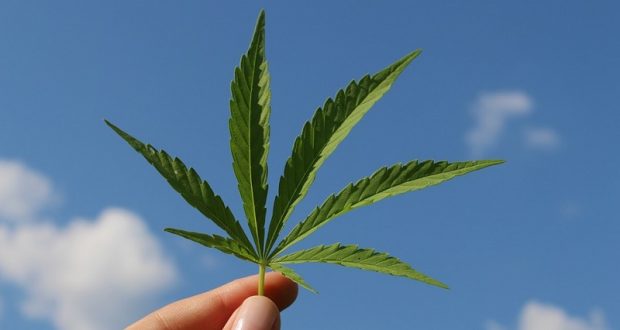MADERA — Madera County supervisors are poised to give the “green” light to large-scale commercial production of industrial hemp in the county.
At their regular meeting this week, supervisors are scheduled to be briefed on the latest developments regarding hemp by County ag commissioner Stevie McNeill. Last year, McNeill described the booming hemp industry as “the Wild West” — with entrepreneurs and farmers alike scrambling to get a piece of the action.
According to McNeill, some industrial hemp farmers around the country are reportedly grossing as much as $50,000 an acre. By comparison, almonds gross about $5,200 per acre, McNeill reported. And industrial hemp does not take any more water to grow than cotton or almonds, about 2 to 3 acre/feet per acre — and it can yield two crops a year.
“This is a cash crop that Madera County can really make some money on,” District 5 Supervisor Tom Wheeler said last year when the new ordinance was first being discussed.
“People have been using [hemp] since George Washington’s time. He grew it himself,” Wheeler added. “Today, the medicine part of it is where the big money is.”
Wheeler said he uses CBD oil — which is produced from industrial hemp — to treat his own pain. “The stuff really works,” he said.
Worldwide, the CBD oil market is projected to be a $20 billion industry by 2022.
Industrial hemp, the non-psychoactive cousin of cannabis, is defined under the California Food and Agricultural Code as “a fiber or oil seed crop, or both, that is limited to types of the plant Cannabis sativa L. having no more than 0.3 percent tetrahydrocannabinol (THC).”
THC is the principal psychoactive ingredient in cannabis. Proponents of hemp, which is used in a variety of commercial products from clothing and accessories to medicinal CBD oil, stress the fact that industrial hemp does not contain enough THC to induce a “high.”
“Most of the new interest in industrial hemp is for its cannabidiol (CBD) oil properties,” stated a staff report supervisors reviewed before Tuesday’s meeting. “This CBD oil extract is used for therapeutic purposes and is being infused into a variety of products including lotions, ointments, drinks, snacks, and human and animal food supplement. Visually, the types of industrial hemp grown for CBD oil are indistinguishable from the high THC cannabis strains used for recreational purposes.”
Under the new eight-page ordinance, which contains a dozen sections, two types of entities will be allowed to grow industrial hemp: Established Agricultural Research Institutions (EARI) and commercial industrial hemp growers.
While industrial hemp has already been grown in the county on a limited basis for more than a year, the new ordinance establishes more specific guidelines with regard to county liability, permitting and enforcement. The new County ordinance, according to the staff report, would further regulate industrial hemp production in several important aspects, including:
- County registration and issuance of a County permit will be required to cultivate industrial hemp — either as an EARI or a commercial grower;
- Only one County permit will be issued per person/business;
- Parcels for commercial growers will be a maximum of fifty (50) acres in size;
- Parcels for EARIs will be a maximum of one (1) acre. (EARIs are limited to “Institutions of Higher Education,” as defined under federal law);
- Growers may be liable for all abatement and enforcement costs under the ordinance, including costs associated with multiple responses by law enforcement authorities to cultivation locations for hemp thefts or other criminal activity related to hemp cultivation;
- Growers must consent to County inspection of cultivation locations to ensure compliance with the Ordinance and permit conditions.
“The regulations that will be put in place by the Ordinance are rationally related to the County’s interest in allowing the cultivation of industrial hemp, while also mitigating the unique legal, land use, environmental, and public health and safety issues associated with this particular agricultural commodity,” said the staff report. “The regulations will be applied consistently throughout the County and are designed to be no more restrictive than are necessary to adequately address the aforementioned issues.”
State law and regulations regarding industrial hemp production are “in flux, and may change in the near future,” the staff report added, “possibly necessitating future amendment of the Ordinance and the definitions contained therein… It is anticipated that there may be additional rules, regulations, standards, and cost requirements associated with the permits as necessary to carry out the Ordinance,” state the report.
Industrial hemp is a relatively new crop in the Golden State. In Dec. 2018, the president signed into law the 2018 Federal Farm Bill, which removed industrial hemp from the federal list of controlled substances, authorized the USDA to create quality control standards for industrial hemp and gave states the ability to adopt their own state plans to exercise primary regulatory over the production of hemp within the state.
In late May 2019, the California Department of Food and Agriculture (CDFA) proposed emergency regulations to establish industrial hemp guidelines. In its submission, CDFA declared that the absence of hemp regulations “constituted an emergency” and immediate action was necessary “to prevent serious harm to the general welfare of the citizens of California.”
Based on its calculations, CDFA officials said the absence of hemp regulations could result in “potential losses for California farmers,” given that hemp is currently one of the most profitable crops per acre currently being cultivated commercially.
Industrial hemp strains grown for their CBD oil properties are indistinguishable from the high THC cannabis strains used for medical and recreational purposes so permitting hemp cultivation without a limitation of location of hemp plants may lead to the same type of odor and public safety issues facing cannabis operations in cities and counties allowing the cultivation of cannabis.
The new regulations also state that hemp can be grown no closer than 100 feet from the property boundary line — and at least one-quarter mile away from any property containing a residence, with the exception of a residence owned or occupied by a permit holder.
And all parcels where hemp is being grown, according to the new ordinance, will have to maintain on-site signage with bright, “sharply contrasting” 5-inch lettering to deter potential theft by persons believing the crop is intoxication-producing cannabis.
If approved by supervisors at their Tuesday meeting, the new ordinance will take effect in 30 days.





“Both federal and state restrictions on hemp have loosened in recent years. As a result, the value of hemp has skyrocketed, said Dmitry Kurouski, assistant professor of biochemistry and biophysics at the Texas A&M University College of Agriculture and Life Sciences, who led the study. Hemp is rich in compounds that are prized for their medicinal properties and flavor. The most well-known is CBD, or cannabidiol, which is thought to help with pain, anxiety and depression.
But farmers wanting to grow valuable hemp plants need a way to know that the plants contain little to no THC. When hemp can be legally grown in Texas later this year, producers will want to know if their plants’ THC levels are approaching 0.3%, which would classify the plants as marijuana and therefore illegal to have and grow. An easy test for THC would be a boon for farmers as well as for law enforcement. –Azriel from https://biomdplus.com/full-spectrum-cbd-oil/“
The dawn finally breaks. Two things have been plainly obvious for at least thirty years.
1) There never was any good reason to outlaw cannabis in any form, in the first place. The laws were based on racism, ignorance, and nonsense, and there never was any evidence presented to show that cannabis was actually dangerous, or that the law was necessary. As one example, one “expert” testified in court, under oath, that marijuana could make your fangs grow six inches long and drip with blood. He said that when he tried it, it turned him into a bat. He was the ONLY “expert” who thought marijuana should be illegal, so they appointed him US Official Expert on Marihuana, where he served and guided policy for 25 years.
2) Cannabis has the potential to be a multi-billion dollar crop and where is the very best place in the world to grow anything? As I pointed out years ago, treated properly, cannabis could be a boon for California bigger than the Gold Rush of 1849.
Fun trivia facts: As you may have noticed, in the last thirty years, marijuana has gone from the time when cops shot people to death in their living rooms over pot plants, to being legal.
What you probably don’t know is that this change was brought about by the very first political campaign ever run on the Internet, starting in 1993. What you also probably don’t know is that two of the most important people in that movement lived right here in Oakhurst.
Oddly enough, Oakhurst, California is one of the key sites in the history of national marijuana legalization.